Sorbet Cardinale (raspberry-blackcurrant sorbet)
Sorbet Cardinale, a delicate flavour composed of raspberries and blackcurrants, seems to be quite rare these days. This is hard to understand, since it is a very pleasing flavour. And luckily, one does not have to be a Catholic Eminence to enjoy this delicate, very berry sorbet! As a little extra, this post will also look into the use of gelatin as a stabiliser in sorbets [that part is optional, however, so hardcore vegetarians can safely continue to read 🙂 ].

The French Cardinal de Richelieu, probably one of the most well-known cardinals throughout history. Richelieu has gone down in history not so much for his religious endeavours but as a great (although quite ruthless) statesman, immensely influential in his time. He also figures as one of the main antagonists in Alexandre Duma’s “The Three Musketeers”, and even had a certain hand in the long chain of events that ultimately would lead up to the establishment of Canada. Whether he also enjoyed raspberries and blackcurrants is unknown to me 😉
After the Pope, cardinals are the highest ranking officials in the Roman Catholic church. I have not been able to find much history about Sorbet Cardinale, but it would seem that the basic recipe (equal parts raspberry and blackcurrants, though some other variations exist) is a rather old one, probably originating either in France or in Italy.
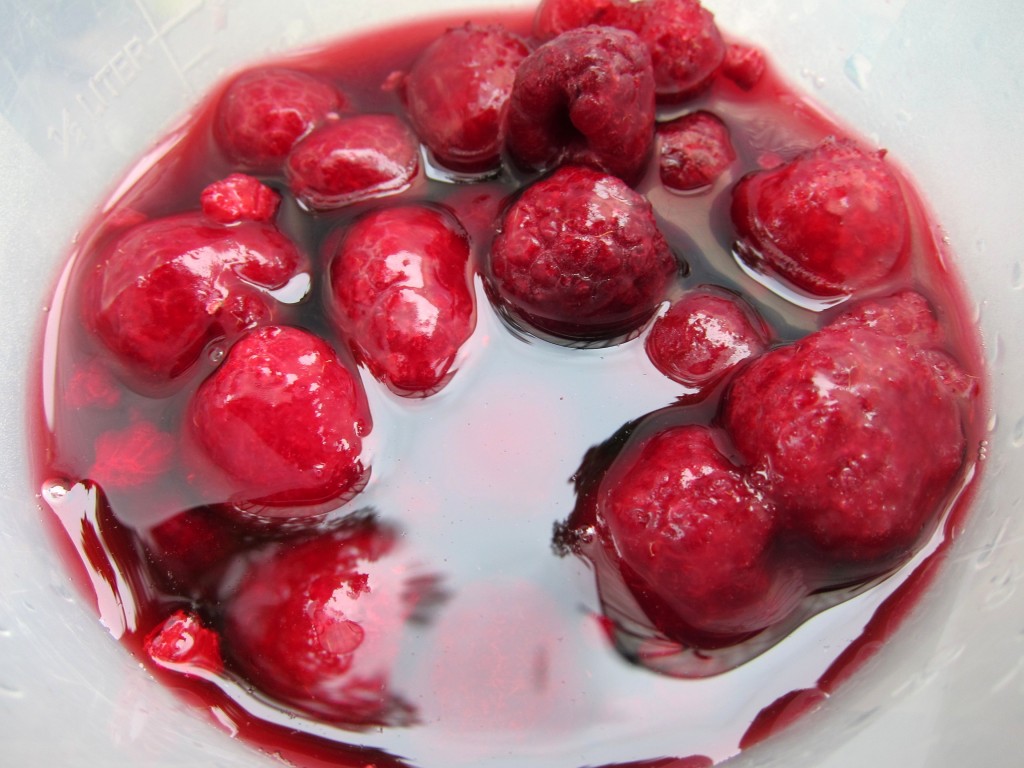
Raspberry and (here) blackcurrant juice. Yes, you can use good quality juice in case you do not have access to fresh or frozen blackcurrants.
Preparing the sorbet – short, sweet and easy!
For all its quite sophisticated flavour, it is really easy to prepare this sorbet: if you can mix a sugar syrup (i e, combine water and sugar) and purée berries, you are basically there!
Should you like to test using gelatin in your sorbet, begin by soaking two sheets in a bowl of cold water. Leave the gelatin sheets to soak for at least ten minutes.
The sugar syrup can be made the classic way (heating the water-sugar mix until the sugar has dissolved completely) or the quick way (blend, shake/stir until all sugar has dissolved). While there possibly might be some micro-molecular benefits of heating the sugar syrup, most people would – in the end – probably not notice any particular difference between the two methods. So, in case you feel a little rebellious and/or want to speed up the process, preparing the sugar syrup without heating anything does come with certain advantages.
Once you have a (cold) sugar syrup ready, go ahead and puré the berries (adding a little extra sugar to sweeten them). I should add that if you have trouble finding fresh or frozen blackcurrants, you could replace them with a good-quality blackcurrant juice (using juice instead of berries would decrease the total amount of solids, but since we are going to use gelatin, the sorbet will end up with a nice, reassuring texture and body anyway).
Mix the berry purée with the sugar syrup, adding the juice of about 1 lemon to offset a too sweet endresult. In case you don’t intend to use gelatin, the base is now ready for churning.
Mixing in the gelatin (if using)
Gelatin is a gelling agent derived from collagen. Since it typically is made from animal by-products, there are many who prefer not to use it. And let me state that it is perfectly feasible to prepare Sorbet Cardinale without using gelatin: in fact, even if you (like me) have no principal problems with gelatin, adding any stabiliser to sorbets is usually unnecessary if the aim is to enjoy them relatively soon after churning. In those cases, a proper amount of sugar in the sorbet base should typically ensure a good, sorbet-sufficient structure anyway. On the other hand, if the sorbet is likely to spend some time in the freezer before being used, it may be more interesting to consider different ways of keeping it in good shape. In case you have no ice cream machine and use still-freezing, extra stabilisation is also something to consider in order to gain better end-results.
Gelatin is one way, and while there are others, it never hurts to have a few options to choose between, right? Gelatin tends to be inexpensive and readily available in “normal” shops. Using gelatin in frozen desserts is very simple and generally yields very good results!
While some claim that gelatin tends to impact negatively on the flavours, tends to make the ice cream rubbery etcetera, this is certainly not my experience. On the contrary: provided that the dosage is appropriate, gelatin tends to do its job in a very efficient, unobtrusive manner (today’s recipe being a case in point).
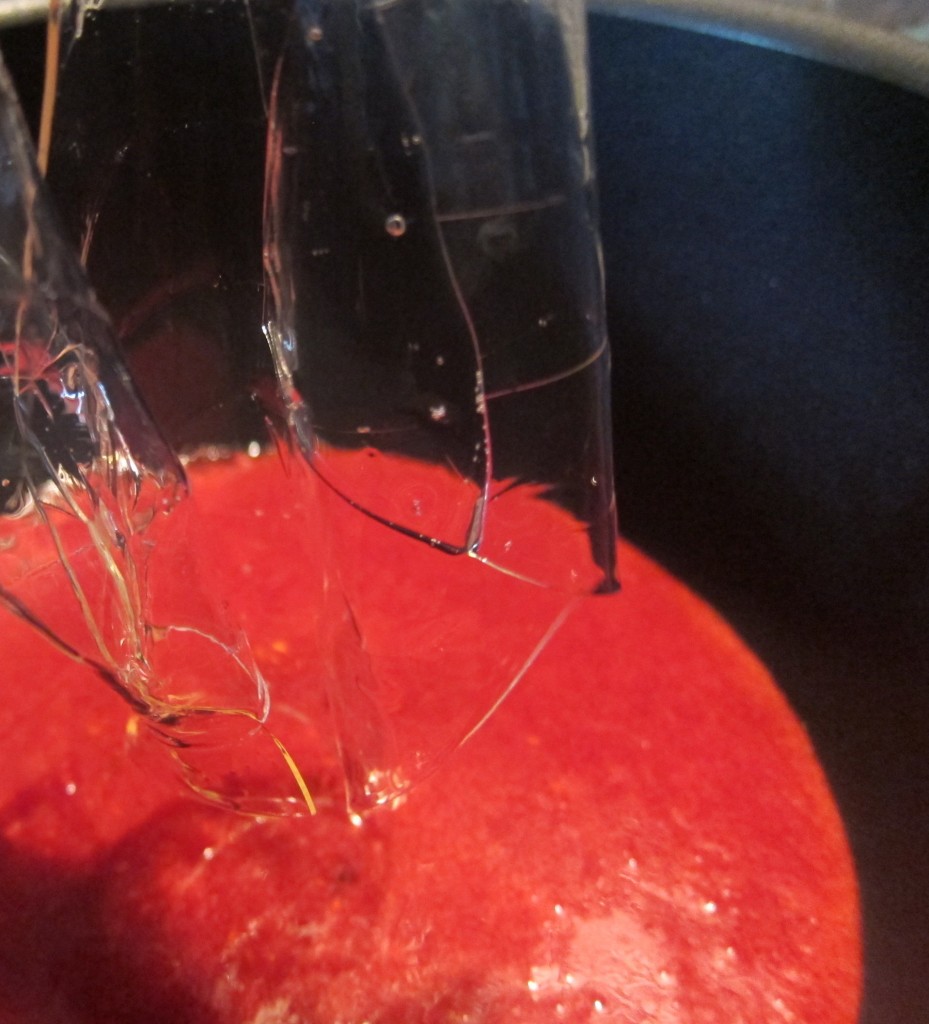
Once your small amount of sorbet base is properly heated, dissolve the wet sheets of gelatin (don’t try to wipe them dry!)
Take about 100 ml (about 1/4 cup) of the sorbet base and pour in a saucepan. Heat to about 40-50° C (104-122° F), add the (still wet) sheets of gelatin and let dissolve – this should only take a few seconds. As soon as the gelatin has dissolved, mix in the blend into the rest of the sorbet base. Your gelatin-boosted base is now ready for churning.
Churn in your ice cream machine according to instructions (or – without a machine – still-freeze in your freezer, following the advice given in this post). Ready!
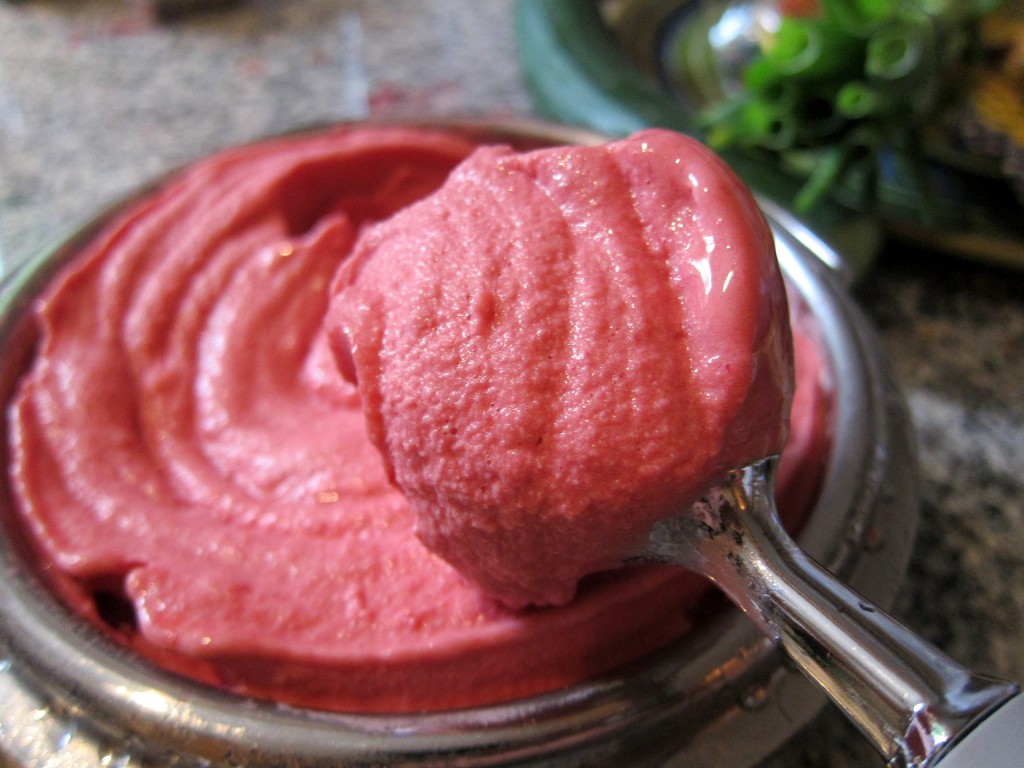
Freshly churned Sorbet Cardinale – a great combination of raspberry and blackcurrant. The noticable “raise” of the sorbet is a tell-tale sign of (extra) stabilisation at work – in this case, the reliable and easily accessible gelatin.
A cardinal sorbet for sorbet lovers
It would perhaps not be a cardinal sin to avoid testing this sorbet, but it certainly would be a great shame, especially if you like ice creams.
The particular intriguing blend of berry flavours, so relatively rarely experienced these days, is good enough reason to have a go at Sorbet Cardinale. The combined mix of the best elements offered by raspberries and blackcurrants certainly stands on its own in a very pleasing way, with the soothing influence of the raspberries somehow reigning in the otherwise often (too) tart impact of the blackcurrants.
The good structure and consistency of the sorbet is also noteworthy, partly thanks to the helpful, non-intrusive addition of gelatin. If the sorbet is destined to be enjoyed pretty much right after churning, however, there is seldom any need to add stabilisers. Those who, for various reasons, do not want to use gelatin can still find other ways (like adding Italian meringue, using plant-based pectin or others; check this post for more on these and other ideas).
Sorbet Cardinale offers a delicate, intriguingly harmonious berry flavour, likely to put a big smile on your lips. And who knows? Sorbet afecionados may perhaps even experince a bit of heavenly bliss ..
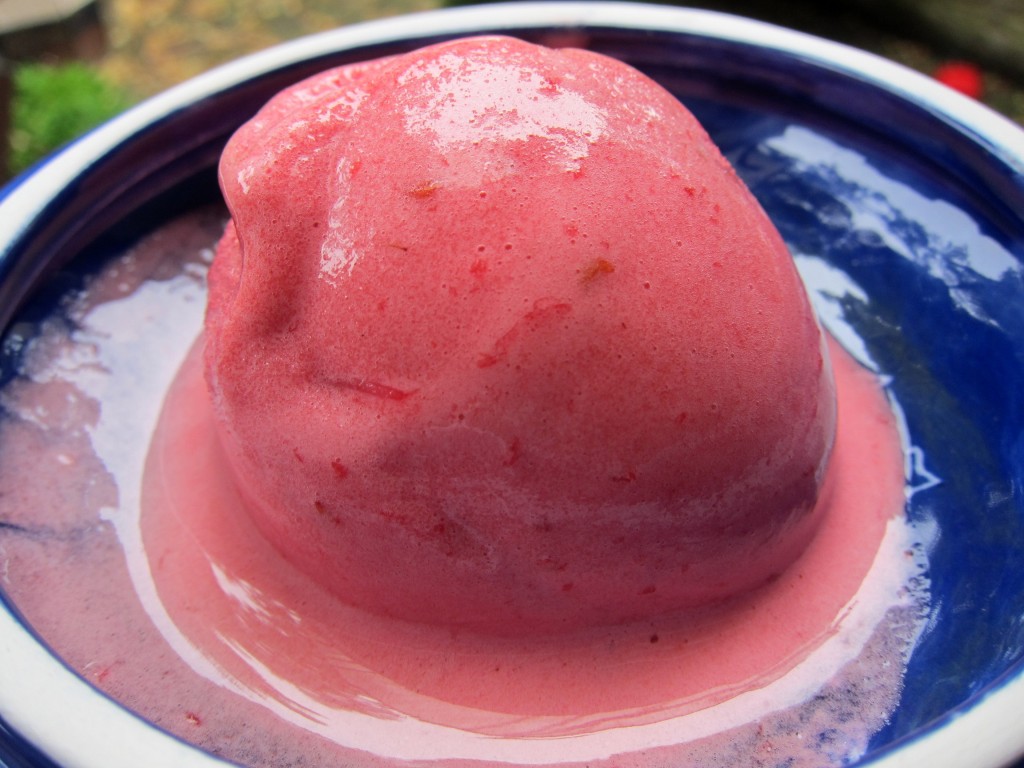
Sorbet Cardinale – freshly churned and delicious. The photo was taken on a particularly hot day. I can assure you, however, that the sorbet has great consistency and texture (despite the impression of too quick-to-melt the photo might provoke)
- 200 ml (4/5 cup) raspberries
- 200 ml (4/5 cup) blackcurrants (or, possibly, good quality juice)
- 400 ml (about 1¾ cup) sugar syrup (made up of equal parts water and sugar)
- about 50 ml (about ¼ cup) extra sugar
- juice of 1 lemon
- (optional: 2 sheets of gelatin)
- Mix the sugar syrup, using equal parts water and sugar. Whether you heat the syrup (classic method) or dissolve the sugar in cold water (quick method), I leave to you.
- Leave the sheets of gelatin to soak in cold water for at least about 10 minutes.
- Mix together the berries/berry juice, add the extra sugar and the lemon juice. The basic sorbet base is now ready!
- Take about ½ cup of this sorbet base and heat to about 40-50° C (104-122° F) in a saucepan. Add the still dripping wet sheets of gelatin and dissolve them (should be a matter of seconds).
- Mix the gelatin-infused part of the sorbet base with the rest of the base.
- Churn in your ice cream machine, or still-freeze using your freezer.
- Enjoy on the spot or put in a freezer-safe container, cover with plastic film and lid and store in the freezer until it is time to serve it.
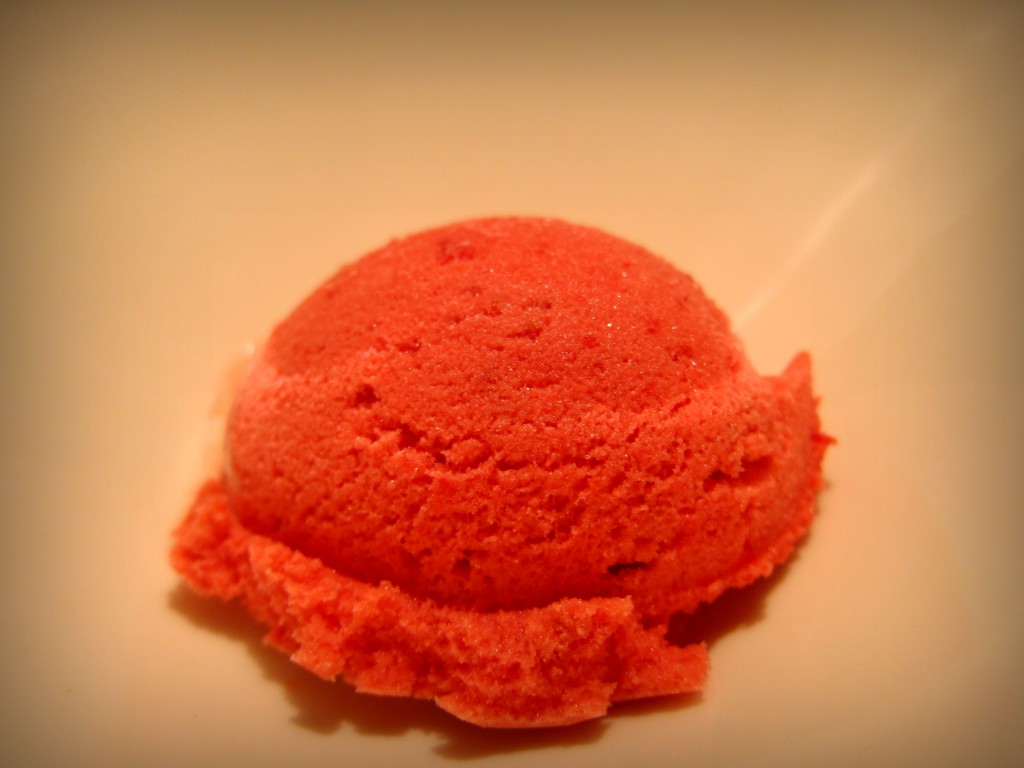
Lousy light, I know, but this is the sorbet after a few hours in the freezer. The consistency is sorbet-perfect and readily scoopable. The taste? Delicious!

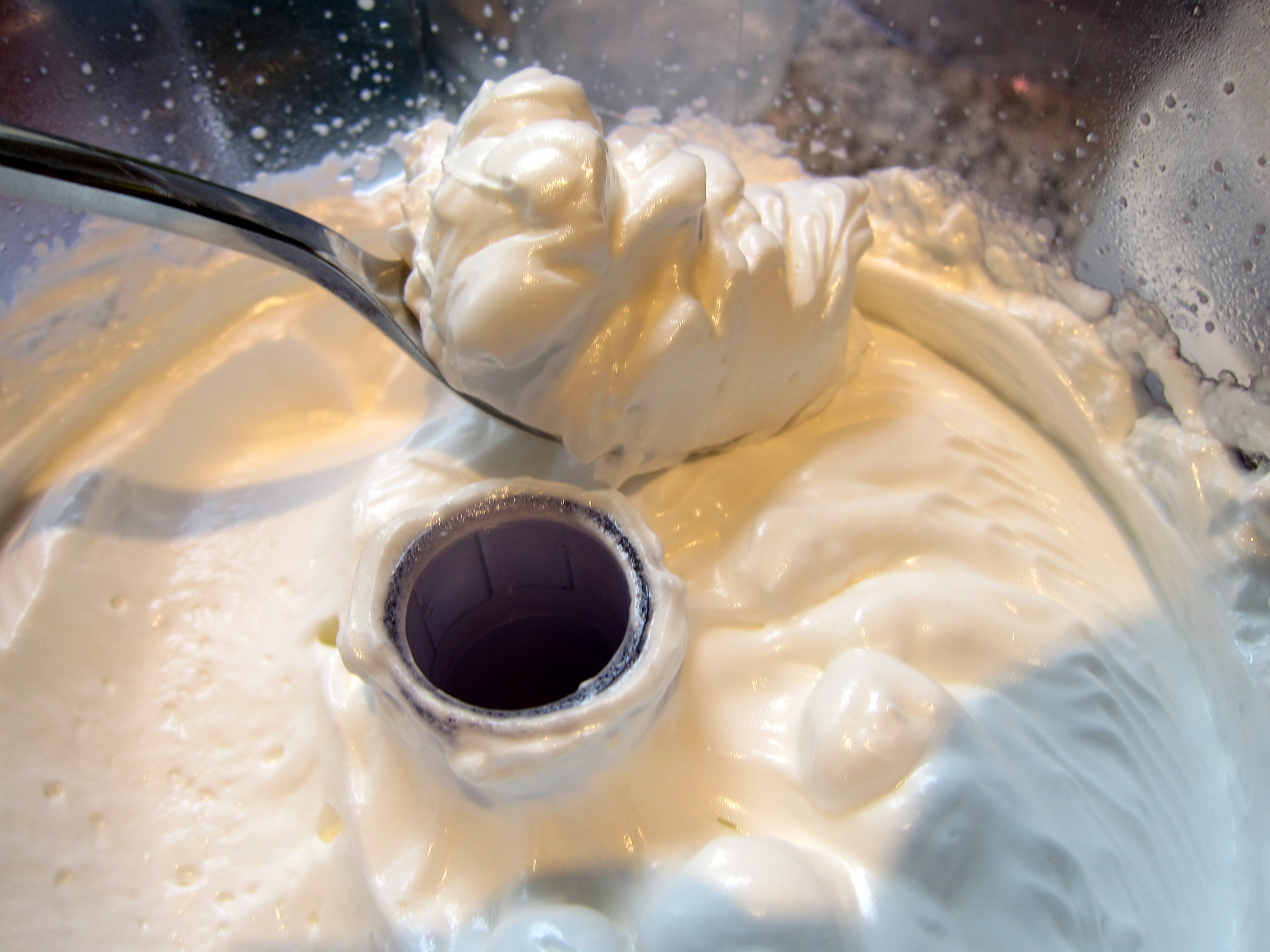
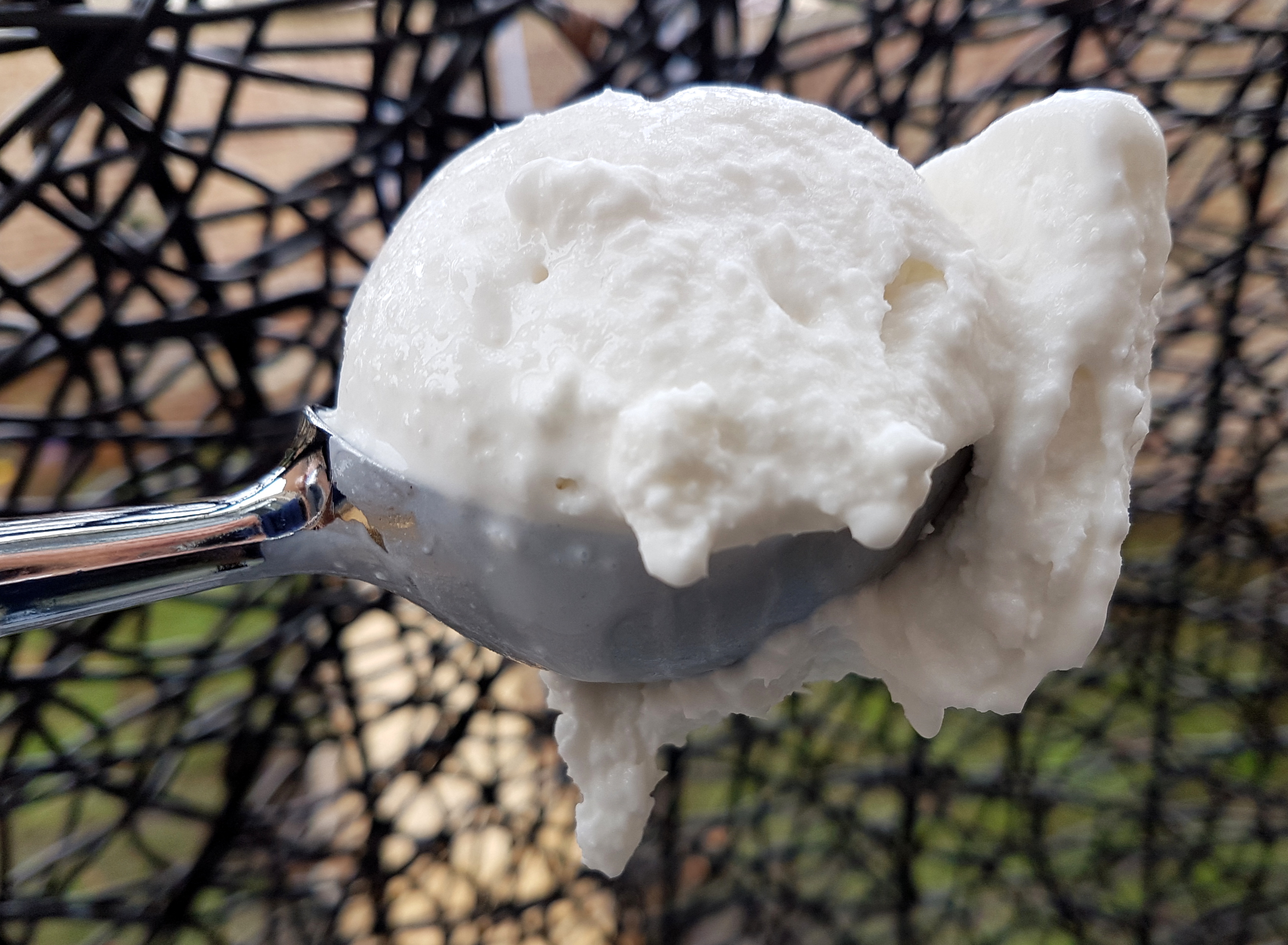


Regarding the sugar syrup: When it says “equal parts” water and sugar, does that mean equal weight or equal volume? I.e., for 100 ml. of water, do I use 100 ml. or 100 g. of sugar?
Berit,
As long as you use caster sugar, weight and volume will (at least for the purposes of smaller batches) equal each other: thus, you can measure the water and the sugar by volume or by weight and both will yield the same result :).
Thank you. Caster sugar is for some reason not available here i Denmark, so I was a bit confused.
I love this recipe and I’ve made it many times. So smooth and delicate! When I had used up all the raspberries and blackberries in my freezer, I tried making it with redcurrants. Not a bad idea at all – it turns the most delicious Barbie pink color and the taste is tart/sweet lovely!
That’s great to hear Berit!